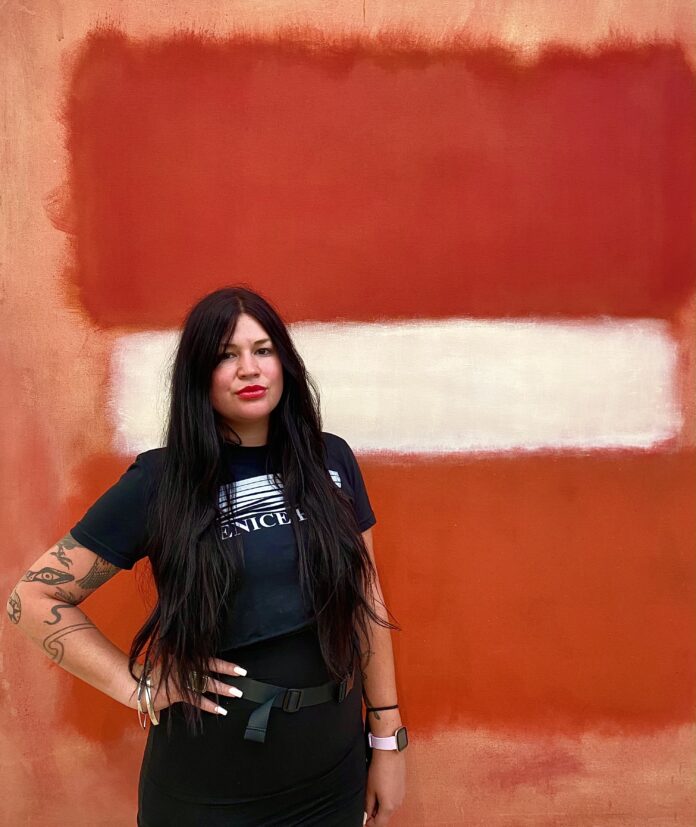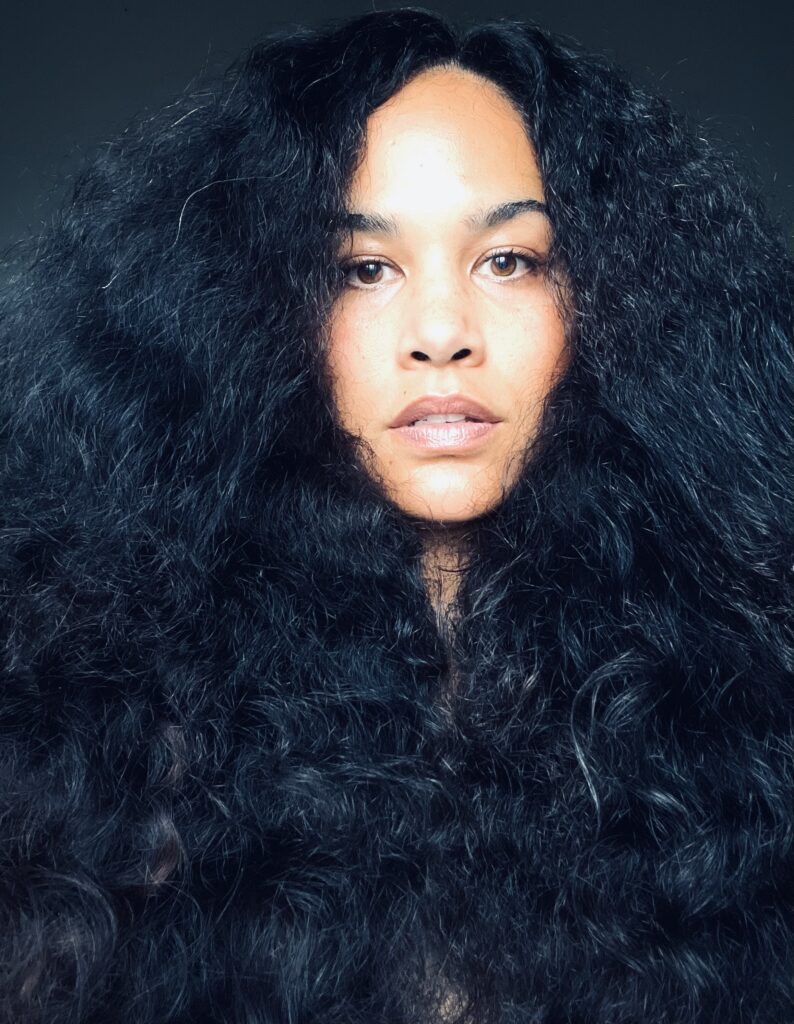
The Eiteljorg Museum’s biennial Native American Fellowship program is an initiative that allows artists to create contemporary works of art while preserving the traditions and history of Native American art. The program contributes to the artistic growth of the community and promotes cultural awareness and appreciation.
Since 1999, the Eiteljorg Museum’s Native American Fellowship program has not only provided Native American artists with a platform but also with a sense of economic empowerment while preserving their heritage and expanding on their narratives. The 2023-24 fellowship marked the first time the fellowship provided its fellows with unrestricted cash awards for $50,000. This is twice the amount of previous fellowships, which were valued at $25,000.

Los Angeles artist Mercedes Dorame, 2023-24 Eiteljorg fellow and member of the Gabrielino Tongva Indian Tribe, was raised in the San Gabriel Mountains of Southern California during the early 1980s. Her artwork often reflects strong ties to her ancestral land, delving into themes such as memory, identity and location.
“I come from the Tongva people,” Dorame said. “We are a landless people, which means we don’t have sovereign territory, and a lot of my work impacts that.”
Dorame’s artwork offers a noticeable balance between traditional and contemporary styles. A visionary artist with an MFA from the San Francisco Art Institute and a bachelor’s in American literature and culture from UCLA, Dorame has captivated the art world with her thought-probing work, ingrained in permanent collections of renowned institutions, including the Hammer Museum, San Francisco Museum of Modern Art and Triton Museum. Dorame has works of photography featured in this year’s fellowship exhibit.
“Every single one of these images was created in a space where I was granted access, where I was allowed access, and I think about what that means and the absurdity of it because it is [my] ancestral land,” Dorame said. “My images are very much based in the land. I try to remain very open, present and conscious of what’s around, recognizing the contributions that the land makes towards us. It is my culture, but it is also my experience of what it means to be a Native American person in a city like Los Angeles, where there is no other home to go back to or reconnect with.”
Dorame also spoke about the systematic yet free nature of her craft.
“I don’t go out and have an idea of what I am going to make or what I am going to look at,” Dorame said. “I try to remain very open, present and open of what I am around, whether that is the trails the animals have made; the plants that are in bloom. I try to interact with a space that acknowledges the contributions that the land makes toward [Native Americans] as well.”
Natalie Ball and Native American Art
Natalie Ball, another 2023-24 Eiteljorg fellow, is well-known for works that challenge the traditional narratives of Indigenous and Native American art. Born in Chiloquin, Oregon, during the 1980s, Ball is a citizen of the Klamath Modoc Tribes and elected official of the Klamath Tribal Council.

“Being a Black Indigenous person, bringing my narrative into this space is really important to me,” Ball said. “I feel like holding the kind of space that my work and narrative does helps people to see a broader range of what the Native American experience is like.”
With a bachelor’s degree in Indigenous, race and ethnic studies and art from the University of Oregon, Ball embarked on a journey of cultural immersion and artistic exploration.
Drawn to the rich heritage of New Zealand (Aotearoa), Ball pursued her master’s at Massey University, delving into the world of Indigenous contemporary art. Guided by a deep tether to her ancestral homelands near southern Oregon, Ball’s dedication to her craft led her to Yale School of Art, where she earned an MFA in painting and printmaking.
“I was raised in a historically Black neighborhood in Portland, and within that was a really active Native American community,” Ball said. “That is where my narrative and history in my art pulls from.”
Ball’s art is heavily influenced by her heritage and upbringing, which she uses to explore identity, history and control issues. Ball utilized unconventional materials, such as deer hide, neon glass and even a Converse basketball shoe, in pieces of art featured in the exhibit.
“My work is heavy on materiality, gesture and humor,” Ball said. “I’m really happy to be a fellow because of who I am, my ancestors and the narratives I bring, and I think it is really important,” Ball said. “Now, I have the opportunity to have a studio [with funds from the fellowship], and I am really excited because now my practice can grow.”
More on Native American Art at Eiteljorg Museum
The works of Native American artists Ruth Cuthand, Raven Halfmoon and Sean Chandler join this year’s fellowship exhibit.
“Though humor softens the blow of a critical message, I have found that making work which confronts the most difficult truths about Canadian society and the impacts of colonization on Aboriginal people are made remarkably palatable when delivered in a strikingly seductive package,” Cuthand said.
Dorene Red Cloud, curator of Native American art at Eiteljorg, also emphasized the ties between her Native American heritage and the exhibit.
“I am a citizen of the Oglala Sioux Tribe of Pine Ridge, South Dakota,” Red Cloud said. “I was born in Chicago because my father was a part of the Federal Relocation Plan of the ’50s and ’60s,” referring to the American Indian Urban Relocation program: A voluntary urban relocation policy implemented by the Bureau of Indian Affairs (BIA) in response to a 1953 federal policy that reduced federal support for Indian tribes and ended the protected status of all Indian-owned grounds.
Although BIA promised to assist with housing and employment, many Native Americans who relocated through this program encountered challenges with adjusting to city life, facing unemployment, low-paying jobs, discrimination, homesickness and the loss of traditional cultural support, according to the National Archives.
Red Cloud highlighted the fellowships’ contributions to preserving and protecting Native American heritage and culture.
“There are some difficult conversations, hard truths, that we can talk about and learn from and not feel guilty about it. It is good to learn the history of what has happened and what is happening because it is not always taught in schools,” Red Cloud said.
“Sadly, some people believe that there are no more Native people, and that simply is not the case. Native American art is definitely having its moment.”
“UNSETTLE/Converge: The Eiteljorg Contemporary Art Fellowship 2023” is on display at the Eiteljorg Museum from Nov. 11, 2023 through Feb. 25, 2024. For more information, visit eiteljorg.org.
Contact multi-media staff writer Noral Parham III. Follow him on Twitter @3Noral. For more stories from Noral, click here.

